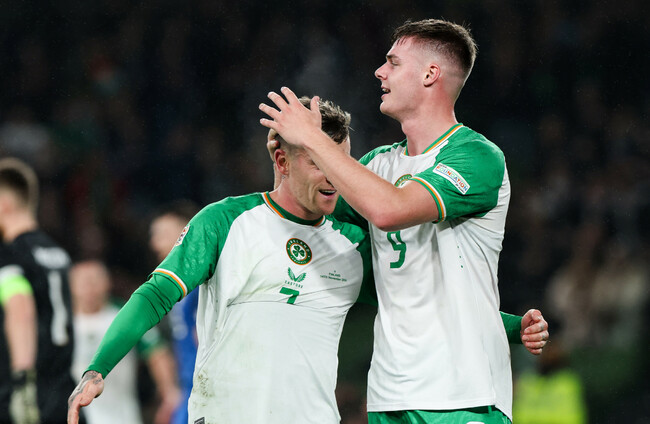LAST NIGHT was Ireland’s 21st Nations League match and their fourth win since the format began in 2018.
Because victories against countries at a similar level have been rare in recent years, it is tempting to get carried away and draw dramatic conclusions from these isolated fixtures.
Recall Ireland’s first win in the Nations League — the 3-0 defeat of Scotland in June 2022.
At the time, it felt like a turning point in Stephen Kenny’s tenure, which had largely floundered up to that point.
Yet what is still probably Ireland’s most impressive standalone performance this decade proved an anomaly and similarly positive results have been hard to come by in the years since.
If anything, Scotland kicked on from that day, as they subsequently qualified for the Euros in impressive fashion.
But what was most memorable from an Irish perspective was the attack.
Both Troy Parrott and Michael Obafemi produced excellent performances, scoring a goal apiece with the match effectively all over after the latter’s spectacular 51st-minute strike.
It’s fair to say that, over the intervening two years, neither player has progressed as rapidly as Ireland fans would have hoped.
Parrott was an unused sub last night while Obafemi was not included in the latest squad and most recently appeared for Ireland in the friendly with Hungary in June.
Both players are still very young and may star for Ireland again. But their complicated trajectories emphasise how difficult it can be to become an established striker at international level.
One of the legacies of the Kenny era is Ireland now have a much younger squad than the one he inherited but at this stage, it would be an exaggeration to call this group inexperienced.
The breakdown of caps for players in the squad is interesting. The three goalkeepers have 23 caps (almost all of which have been won by Caoimhín Kelleher), the eight defenders have 158, the five midfielders have 107 and the seven players listed as attackers have 75.
And the attack was undoubtedly the biggest problem of the Kenny era. Ireland famously scored just one goal in the first eight games of the Dubliner’s reign, and their record only improved marginally from that point on.
The manager was relatively consistent in picking goalkeeper, defence and midfield. The likes of Gavin Bazunu, Dara O’Shea, Nathan Collins, Jason Knight, Josh Cullen and Matt Doherty were close to mainstays in the team, and five of those six featured last night (Bazunu is injured).
But the one less reliable area in terms of selection was the attack.
You never felt Kenny settled on a striker or strikers that could be counted upon to score and play regularly.
Obafemi and Parrott were not the only ones given chances. The attacking players capped by Kenny included David McGoldrick, Shane Long, Callum Robinson, Adam Idah, Aaron Connolly, Sean Maguire, Will Keane, James Collins and Evan Ferguson.
Ferguson is the one who featured last night but Kenny never really got the benefit of the Brighton starlet, as he was raw, young and hampered by injuries during his reign.
Half-time: Republic of Ireland 1-0 Finland
— RTÉ Sport (@RTEsport) November 14, 2024
Evan Ferguson heads home Mikey Johnston's fabulous cross and Ireland lead at the break.
📺 Watch: https://t.co/ZlFZisH3PT
📱 Follow: https://t.co/Y7JqjgvXDr#COYBIG pic.twitter.com/BD1RY938Gh
The Meath native’s goal against Finland was his fourth for Ireland in 17 caps. You could also argue it was his first goal at international level that truly mattered. Two of the previous three came in convincing wins over Gibraltar and the other was in a friendly with Latvia.
Although he has had a frustrating season at club level, with only one Premier League start for Brighton, last night was surely the 20-year-old’s best game in an Ireland jersey, even if he tired in the second half, and was replaced in the 76th minute.
Ferguson was unlucky not to come away with an assist too. He produced an exquisite through ball for Sammie Szmodics, which allowed the Ipswich star to round the goalkeeper and put the ball in the net.
In the end, Szmodics was correctly ruled out for a marginal offside. But this moment indicated a potentially fruitful attacking partnership that could benefit Ireland for years.
The offside flag denies Sammie Szmodics and Ireland the opening goal.
— RTÉ Sport (@RTEsport) November 14, 2024
📺 Watch: https://t.co/ZlFZisHBFr
📱 Follow: https://t.co/Y7JqjgwvsZ#COYBIG pic.twitter.com/iEGxev9qIR
Szmodics was one of the few available attackers not capped by Kenny, though an outstanding season in the Championship for Blackburn last year made him impossible to ignore once John O’Shea became interim boss and he made a belated debut versus Belgium last March.
The 29-year-old is still without a goal after nine caps but regularly proved a handful for the Finnish defenders and with some better luck, he might have come away with a couple.
Ferguson and Szmodics also swapped roles on Thursday evening, showcasing their flexibility, with the former sometimes playing as a number 10, allowing his colleague to be employed as the main striker.
It was also notable that Heimir Hallgrímsson selected the Ipswich player in a central role — he has played more as a left-sided attacker for club and country of late.
The Boys in Green may have only scored one goal, but it was the most threatening they looked against comparable opposition in a competitive fixture for a long time, arguably since that Scotland match.
It is consequently tempting to conclude that Ferguson and Szmodics are destined to lead the line for Ireland in the years to come and inspire a long-term rejuvenation under Hallgrímsson – but as the complex fates of Obafemi, Parrott and the Irish team in general have shown since June 2022, football is seldom so straightforward.












No pity for Ward,was completely unprofessional of him.For a man lucky to get so many caps because of a lack of options in his position the last decade it was a very silly move.
@Nic Antonio: ah now, ward has been one of our only consistent starters in the prem in the last few years
@Jack: Fair enough Jack.
@Nic Antonio: unprofessional ??? He was sharing info with friends of his. It’s a good thing in the long run that it came out.